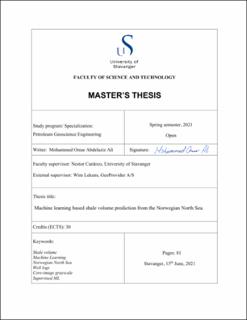| dc.description.abstract | Petroleum geosciences, like other fields, has entered the era of new advanced technologies to handle problems related to complex massive data sets and decision making. The growing quantity of subsurface datasets has created numerous challenges in terms of data analysis reliability, speed, accuracy, and consistency. As a result, data science and machine learning (ML) are quickly gaining traction in the oil industry as a strategy for adding value.
This thesis investigates the application of ML in the field of petrophysics, specifically in the estimation of shale volume (Vsh). The percentage or fraction of shale in the rock, or Vsh, is an important input parameter for some geological applications such as reservoir calculations (e.g., net to gross and average reservoir porosity), fault seal analysis (e.g., shale gouge ratio), and geomechanics.
The motivation for this study is to obtain a fast, reliable, and consistent Vsh model using ML and well data from the Norwegian northern North Sea. For this purpose, several objectives were defined. As the first most important step, a dataset was constructed by generating the Vsh label to train the ML models and selecting the features used by the models. The Vsh label was generated after comparing and validating the different petrophysical methods with core data. Secondly, a supervised regression ML technique was used to build the predictive models.
Classical petrophysical methods for Vsh estimation can be used with a relatively low margin of error, with the nonlinear GR method being the most optimal. In addition, core image grayscale pixel values are effective as a Vsh estimation. The Vsh from the non-linear GR method was used as label for the ML methods. The ML results indicate outstanding performance of the XGBoost algorithm with a validation set root mean square error (RMSE) of 0.078 for the best model. Tuning of the model hyperparameters, adding meaningful features such as lithology index, and making the ML models aware of the wells’ locations, increases the model accuracy (reduces RMSE) as much as 15%. An interesting ML model was built based only on location and depth features, with a validation set RMSE of 0.13. This model could be improved and used to determine Vsh at any location and depth before drilling a well. | |
